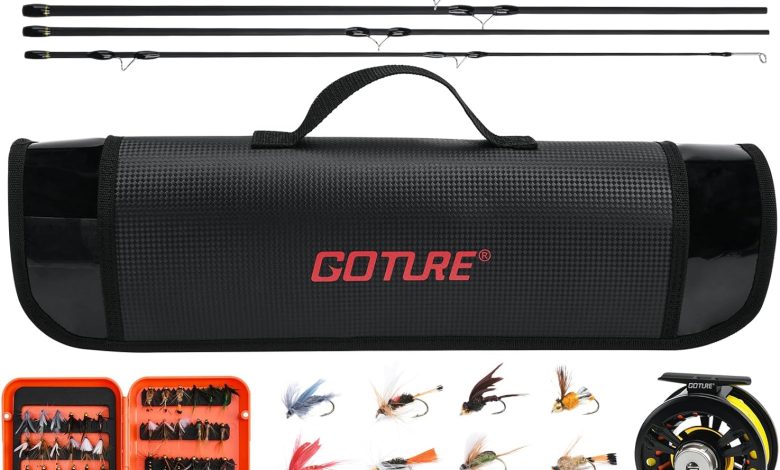Casting Into Adventure: The Ultimate Guide to Choosing the Perfect Fly Fishing Starter Kit

Fly fishing is not just a hobby; it’s a timeless art that connects anglers to nature in a unique and immersive way. If you’re a beginner eager to dive into the world of fly fishing, choosing the right equipment is crucial for a successful and enjoyable experience. In this comprehensive guide, we’ll explore the essential components of a fly fishing starter kit, helping you make informed decisions that set the stage for a lifetime of angling adventures.
Understanding the Basics:
Before delving into the components of a fly fishing starter kit, it’s essential to grasp the basics of fly fishing. Unlike traditional fishing, fly fishing involves using a weighted line to cast a specially designed fly into the water, mimicking the movement of insects to attract fish. This method requires precision and finesse, making the right equipment selection vital for success.
The Components of a Fly Fishing Starter Kit:
- Fly Rod: The fly rod is the backbone of your fly fishing setup. It’s crucial to choose a rod that suits your intended fishing environment and target species. For beginners, a medium-action rod with a length between 8 and 9 feet is a versatile choice, providing a balance of flexibility and power.
- Fly Reel: The fly reel complements the rod, holding the fly line and providing resistance when a fish is hooked. Look for a reel that matches the weight of your fly rod and has a smooth drag system. A large arbor design is preferable, as it allows for quicker line retrieval.
- Fly Line: Selecting the right fly line is essential for casting accuracy. Weight-forward floating lines are ideal for beginners, providing better control and easier casting. The weight of the line should match the weight of your rod for optimal performance.
- Leader and Tippet: The leader is the clear line connecting the fly line to the fly, while the tippet is a finer, transparent line attached to the fly. These components are crucial for presenting the fly naturally and play a significant role in fooling wary fish.
- Flies: Flies are the lures used in fly fishing, designed to imitate insects or other aquatic creatures. A variety of flies should be included in your starter kit, such as dry flies, nymphs, and streamers, to cover different fishing scenarios.
- Fly Box: A fly box keeps your flies organized and easily accessible. Look for a durable, waterproof box with compartments for different fly types. This ensures you have the right fly at your fingertips when needed.
- Accessories: Additional accessories, such as nippers, forceps, and a retractable zinger for holding tools, are essential for streamlining your fishing experience. These small tools contribute to the overall efficiency and enjoyment of your time on the water.
Choosing the Right Fly Fishing Starter Kit:
Now that we’ve covered the individual components, it’s time to discuss how to choose the right pre-assembled fly fishing starter kit. These kits are designed with beginners in mind, providing a curated selection of compatible gear to simplify the decision-making process.
- Quality of Components: Pay attention to the materials and construction of the rod, reel, and other components in the kit. While affordability is a consideration for beginners, investing in a kit with durable and high-quality gear ensures a better overall experience and longevity.
- Rod Action and Length: Consider the environment where you’ll primarily be fishing. A slower-action rod is suitable for small streams, while a faster-action rod may be preferred for larger rivers or lakes. The length of the rod also depends on the type of water you’ll be fishing, with longer rods providing more casting distance.
- Weight of the Rod: Fly rods come in different weights, ranging from 1 to 14, with lighter weights suitable for smaller fish and heavier weights for larger species. For beginners, a 5- or 6-weight rod is a versatile choice that can handle a variety of fishing situations.
- Reel Features: Examine the features of the included reel, such as the drag system and arbor size. A smooth drag is crucial for playing and landing fish, while a large arbor design allows for quicker line retrieval.
- Included Accessories: Evaluate the accessories included in the kit. A well-rounded kit should have a fly box with a variety of flies, leaders, tippets, and basic tools. Some kits may also include instructional materials or DVDs to help beginners get started.
Learning the Art of Fly Casting:
With your fly fishing starter kit in hand, it’s time to learn the art of fly casting. Casting is a fundamental skill that requires practice and patience. Embark on your journey with these valuable starting points:
- Grip and Stance: Hold the rod with a relaxed grip, keeping your wrist straight. Stand with your feet shoulder-width apart and your body facing the direction you want to cast.
- Basic Casting Techniques: Learn the basic casting techniques, including the overhead cast, roll cast, and sidearm cast. Practice these exercises in an open area before hitting the water to build muscle memory and improve your accuracy.
- Timing and Rhythm: The key to successful fly casting is timing and rhythm. Allow the rod to load by smoothly accelerating and stopping the casting motion. Practice with short casts and gradually increase the length as you become more comfortable.
- Mending and Line Control: Understanding how to mend the line on the water is crucial for presenting your fly naturally. Practice mending techniques to avoid drag and achieve a lifelike drift.
- Reading the Water: Pay attention to the water’s flow and features. Look for areas where fish are likely to congregate, such as eddies, seams, and riffles. Learning to read the water enhances your chances of success.
Common Mistakes and How to Avoid Them:
As a beginner, you may encounter some common mistakes while learning fly fishing. Recognizing these pitfalls and knowing how to avoid them can accelerate your learning curve and improve your overall experience.
- Overloading the Rod: Avoid using a line that is too heavy for your rod. Overloading the rod can result in poor casting performance and increased frustration.
- Ignoring Proper Knots: Secure knots are crucial in fly fishing. Learn and practice essential knots, including the improved clinch knot for attaching flies and the loop-to-loop connection for joining the leader and fly line.
- Casting Too Hard: Fly casting is about finesse, not strength. Casting too hard can lead to inaccurate casts and tangles. Focus on smooth and controlled movements for better results.
- Neglecting Line Management: Proper line management is essential for a successful fly fishing experience. Pay attention to the position of your line on the water, mend as needed, and be mindful of drag to achieve a natural presentation.
- Impatience: Fly fishing requires patience and persistence. Be prepared for a learning curve, and celebrate small successes along the way. Enjoy the process of improving your skills and understanding the nuances of the sport.
Conclusion:
Embarking on the journey of fly fishing is an exciting adventure that connects you with nature and offers a unique angling experience. Choosing the right fly fishing starter kit sets the foundation for success, providing you with the essential tools to enjoy this timeless pursuit. Remember to invest time in learning the art of fly casting, practice regularly, and embrace the challenges and joys that come with fly fishing. With the right knowledge and equipment, you’ll be well on your way to creating lasting memories on the water. So, grab your fly fishing starter kit, head to your favorite fishing spot, and cast into the world of adventure that awaits!
You can also read our blog: Fishing Charter USA: Your Ultimate Guide



